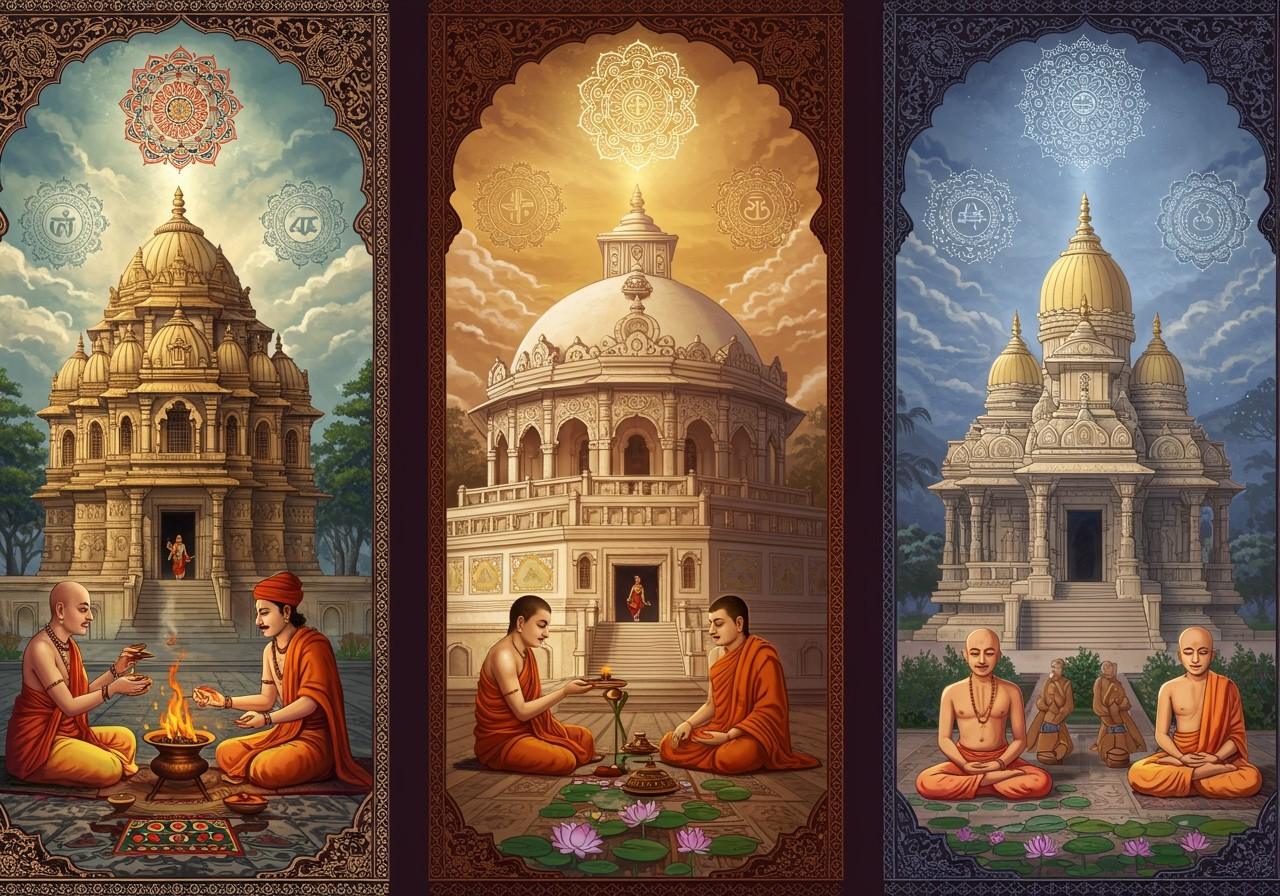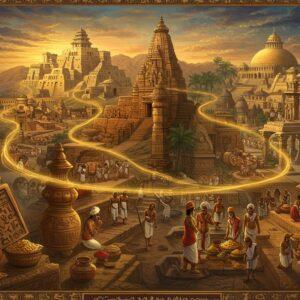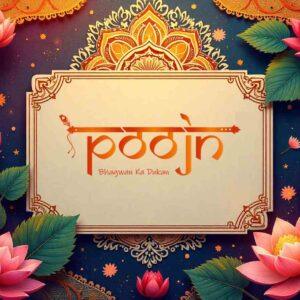
The Gupta Era, often referred to as the Golden Age of India, spanned from the mid-3rd century to the mid-6th century CE. This period witnessed a remarkable flourishing of religious and cultural practices. The Gupta Dynasty saw a resurgence of Hinduism, particularly Brahmanism, with Vaishnavism and Shaivism as prominent branches. Rulers like Chandragupta II and Samudragupta actively promoted Hinduism through temple construction and Vedic rituals. Buddhism and Jainism also maintained a significant presence, contributing to the rich spiritual landscape of the time. Let’s delve into the development and societal influence of these faiths during this remarkable period.
Hinduism During the Gupta Dynasty
Hinduism experienced a revival under the Gupta rulers. They emphasized Vedic traditions, rituals, and temple worship. The construction of magnificent temples, such as the Vishnu Temple at Deogarh, exemplified their devotion. The Guptas patronized Brahmins and promoted Sanskrit literature, leading to important religious texts like the Puranas. These texts played a key role in shaping Hindu practices and integrating various regional deities into mainstream Hinduism. Artistic depictions of gods and goddesses flourished in sculptures and paintings.
Buddhism’s Continued Practice During the Gupta Era
While Buddhism experienced a decline in urban centers, it continued to thrive in monasteries and rural areas during the Gupta Era. Significant constructions included Buddhist stupas and monasteries at prominent sites like Sanchi and Nalanda. Scholars like Vasubandhu and Asanga made significant contributions to Buddhist thought. Artistic representations of Buddha and Bodhisattvas prospered, and Mahayana Buddhism began its spread towards East Asia. This period was marked by mutual respect between Buddhist and Hindu communities.
Jainism’s Role and Patronage During the Gupta Dynasty
Jainism, while less dominant than Hinduism and Buddhism, held a significant presence during the Gupta period. Some Gupta rulers extended their patronage to Jainism, leading to the construction of Jain temples. Jain scholars contributed valuable works in Sanskrit. Artistic representations of Jain Tirthankaras were notable in art and sculpture. Jain communities maintained their distinct practices and rituals, spreading their beliefs to different regions. Interactions between Jainism and other religions demonstrated a harmonious coexistence.
The Interplay of Religion, Art, and Architecture
Religious practices profoundly influenced art and architecture during the Gupta Era. Grand temples, stupas, and monasteries were constructed with distinctive features, including intricate carvings. Sculptures and paintings prominently featured deities, Buddha, and Tirthankaras. Religious literature, encompassing poetry, drama, and sacred texts, also flourished. The symbolism and iconography employed in religious art highlighted the significant contributions of Gupta-era artists and architects to India’s cultural heritage.
Social and Cultural Impact of Religious Practices
Religion played a pivotal role in shaping social norms and values during the Gupta Era. The resurgence of Hinduism, especially Brahmanism, influenced various aspects of daily life. Festivals like Diwali and Holi, deeply rooted in Hindu traditions, became important cultural events, fostering community and continuity.
Education and scholarship thrived under the patronage of Gupta rulers. Religious institutions like temples and monasteries served as centers of learning. Nalanda University, primarily a Buddhist institution, attracted scholars from diverse backgrounds, including Hinduism and Jainism. These centers of learning contributed to advancements in science, mathematics, and literature.
Religious practices were woven into the fabric of daily life, influencing everything from dietary habits to social ceremonies. Rituals performed at home and in temples provided a structured way for people to connect with their faith. Religious leaders offered guidance that shaped governance and politics. Influential figures like Chandragupta II and Samudragupta actively promoted Hinduism through temple construction and Vedic rituals. Despite the prominence of Hinduism, Buddhism and Jainism continued to thrive, creating a rich tapestry of religious diversity.
How Poojn.in Supports Your Connection to Gupta Era Religious Practices
Poojn.in, India’s leading online store for cultural and religious goods, offers a wide selection of products that can help you connect with the rich traditions of the Gupta Era. We provide high-quality items for Hindu rituals, Buddhist practices, and Jain ceremonies, allowing you to incorporate these ancient customs into your modern life.
For Hindu Rituals:
- Complete Puja Samagri Kits: Source authentic ingredients conveniently packaged for your puja needs. We ensure quality and completeness so you can perform your rituals with ease.
- Copper and Brass Items: Discover beautifully crafted ritual items made from pure copper and brass, reminiscent of Gupta period designs. These items add a touch of tradition and elegance to your puja space.
- Traditional Dhoop and Agarbatti: Enhance your temple worship with traditional dhoop and agarbatti, creating a sacred and aromatic atmosphere. Choose from a variety of fragrances to elevate your spiritual experience.
- Vedic Ritual Items: Find all the necessary items for yagyas and havans, ensuring that your Vedic rituals are performed with authenticity and precision.
For Buddhist Practices:
- Meditation Cushions and Prayer Mats: Enhance your meditation practice with comfortable cushions and mats, promoting focus and tranquility. We offer a variety of styles and materials to suit your preferences.
- Brass and Copper Singing Bowls: Experience the soothing sounds of traditional singing bowls, perfect for meditation and relaxation. Our bowls are crafted with care to produce rich and resonant tones.
For Jain Ceremonies:
- Pure White Cotton Vastras: Find pristine white cotton vastras for Jain ceremonies, upholding the tradition of purity and simplicity. We offer a range of sizes and styles to meet your specific needs.
- Metal Pratima Stands and Platforms: Display your revered pratima with respect and elegance on our sturdy metal stands and platforms. These stands are designed to enhance the beauty and sanctity of your sacred space.
Visit Poojn.in today to explore our complete collection and bring the spiritual richness of the Gupta Era into your life.
Conclusion
The Gupta Era stands as a testament to the profound influence of religious practices on shaping society and culture. Hinduism, Buddhism, and Jainism played integral roles in molding the values and norms of the time. Festivals, education, art, architecture, and literature flourished under the patronage of the Gupta rulers and the flourishing religious landscape. The harmonious coexistence of these diverse faiths fostered mutual respect and enriched the spiritual tapestry of India. The legacy of the Gupta Era continues to resonate within Indian traditions, reflecting the enduring power of faith and spirituality in shaping our world.


